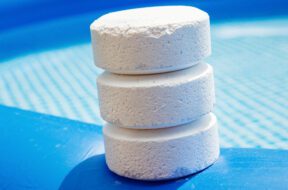
Want to learn more about algaecide? Read on to find out when to add algaecide to your pool maintenance routine and other helpful tips.
Pool algae is an unfortunate yet common consequence that many pool owners face. Once this microscopic plant finds its way from the environment to your pool – maybe on an inconspicuous piece of clothing or a once lakeside inflatable – this plant will multiply rapidly and manifest itself in several different ways in your pool.
Pool algae is most often introduced after an object contaminated with spores from the natural environment contacts the pool. However, pool algae can also be carried through the wind. That is why algal bloom may occur after high winds or a storm.
While it is not typically harmful to swimmers, pool algae can be unsightly. It can also become the host for an array of bacteria which may be harmful.
To know how to treat your pool for algae, you must be able to determine what type of algae has taken residence in your pool.
There are three major types of pool algae: green, yellow, and black.
Green algae is the most common form and is the easiest to remove. However, any spores left behind after cleaning can cause a nearly instant re-bloom. It can be prevented through maintaining proper pool sanitation and filtration.
Yellow algae is a much tougher pool algae to face. Chlorine resistant, yellow algae is rare and will be found in the corners of your pool, often around steps or ladders. This algae type will require double the shock to kill compared to green algae.
Black algae is perhaps the most aggressive form. It can be difficult to remove, so be vigilant when scrubbing. Use three to four times the amount of shock to kill this type of algae.
If you own an automatic pool vacuum for water waste, don’t use it! This can cause the re-release of algae spores through the pool’s filter. Instead, vacuum the contaminated water manually. Make sure to remove as much algae as possible, including sediment around the bottom and sides of the pool.
Once you remove the sediment, scrub off anywhere that pool algae has accumulated with a pool brush. Ensure no algae is left sticking to the sides of the pool or tucked away corners.
Once you have vacuumed and scrubbed, the simplest way to kill algae is to shock your pool with calcium hypochlorite. A good ratio is one pound of shock per 10,000 gallons of water in your pool, though this concentration should be increased depending on your case of algae.
You should test your pool’s alkalinity, pH, and chlorine levels throughout this process. An unbalanced pool may be the reason for algae growth in the first place. Be sure to retest after shocking your pool and ensure the chlorine levels are fit for swimmers.
After the algae has been properly shocked, your pool will likely turn a murky blue color. Keep the filter running continuously until the water runs clear. You can use a clarifier to speed up the process. If your pool water it is still the same color, and your chlorine levels have dropped below 5ppm, you will likely have to re-shock to kill the algae.
To prevent pool algae, the best thing you can do is shield your pool from the elements. This means covering the pool when it is not in use, maintaining proper pool sanitation, and rinsing materials which come into contact with the natural environment.
You can also use an algaecide as a preventative measure in climates where algae growth may be common. Be sure to keep your free chlorine at recommended levels and regularly check to ensure your filters are working.
Even the most caring pool owners can suffer with pool algae. Be mindful with prevention and treatments so you can maintain a clear, algae-free pool.

Want to learn more about algaecide? Read on to find out when to add algaecide to your pool maintenance routine and other helpful tips.

In this quick guide, we’ll answer the question “can you over shock a pool” and unveil the factors to consider when shocking a pool.

Maintaining both pH and total alkalinity in your swimming pool is important for keeping your pool properly sanitized and non-corrosive. Total alkalinity is to pH what cyanuric acid is to free chlorine. Total alkalinity stabilizes pH levels. The ideal pool pH level is 7.4 to 7.6. The ideal total alkalinity level is 80 to 120 ppm.

The Association of Pool and Spa Professionals recommends free chlorine levels for both swimming pools and hot tubs be kept between 2.0 and 4.0 ppm. However, the Center for Disease Control recommends free chlorine stay above 1 ppm in pools and 3 ppm in hot tubs.